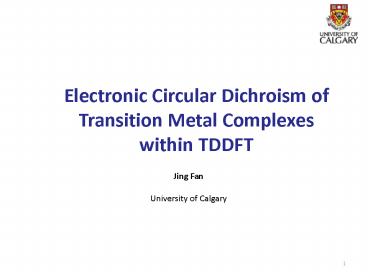Electronic Circular Dichroism of Transition Metal Complexes within TDDFT - PowerPoint PPT Presentation
1 / 26
Title:
Electronic Circular Dichroism of Transition Metal Complexes within TDDFT
Description:
To understand, experimental CD spectra, quantum ... Trigonal Dihedral: ... Complexes with Conjugated Ligands (Trigonal Dihedral) M: Fe, Ru, Os. N-N: bpy, phen ... – PowerPoint PPT presentation
Number of Views:339
Avg rating:3.0/5.0
Title: Electronic Circular Dichroism of Transition Metal Complexes within TDDFT
1
Electronic Circular Dichroism of Transition Metal
Complexes within TDDFT
Jing Fan University of Calgary
2
Objectives
- To understand, experimental CD spectra, quantum
mechanical calculations of electronic structure
and CD based on TDDFT - To elucidate the origin of CD in typical
transition metal complexes, relationship between
CD and molecular geometry - To evaluate the reliability and accuracy of TDDFT
for transition metal compounds
3
Complexes Studied
Trigonal Dihedral
- ?-bonded complexes M(en)33 (M Co, Cr)
(d-to-d, L?MCT)
- both ?- and p-bonded complexes M(L-L)3n (M
Co, Cr L ox, acac, thiox, etc.) (d-to-d,
LMCT, MLCT, LC)
- complexes with conjugated ligands M(L-L)32
( M Fe, Ru, Os L bpy, phen) (LC exciton CD )
4
Computational Details ADF package
- Basis sets (STO)
- ligand atoms frozen core triple-? polarized
TZP -C, N, O (1S) S (2p) - metal atoms
- -Co, Cr TZP (2p)
- -Fe, Ru, Os TZ2P (2p, 3d, 4f)
- Functionals VWN (LDA) BP86 (GGA)
- Relativistic effect for Fe group metals (scalar
ZORA) - Un-restricted calculations for Cr(III)
- The COnductor-like continuum Solvent MOdel
(COSMO) of solvation
5
?-bonded Complexes Co(en)33 and Cr(en)33
en
- Calculated ?E are systematically overestimated
for the d-d region (by 5,500 cm-1)
underestimated for the LMCT region (by 6,000
cm-1)
6
Assignment of Transitions
Lowest singlet excited states and their splitting
in D3 symmetry
?-Co(en)33
7
Why Optically Active?
1A1g 1T1g d-d transitions magnetically
allowed 1A1g 1T1u LMCT transitions
electrically allowed
8
Origin of Optical Activity
- Metal-ligand orbital interactions
8
- Metal-ligand Orbital Interaction
- Metal-ligand Orbital Interaction
9
(No Transcript)
10
MO diagram
Energy (eV)
10
11
- Prediction of the Sign of Rotatory Strengths
and in terms of one-electron excitations 4e(d?)??
5e(d?)
12
Both ?- and p-bonded Complexes
Metal and Ligand Frontier Orbitals
L?-orbitals
L?-orbitals
12
- Metal-ligand Orbital Interaction
- Metal-ligand Orbital Interaction
13
Symmetry Unique Metal-ligand Orbital Overlaps
Only p-orbitals on the N atoms are considered
13
14
Case I Oh Case II D3
15
CD spectra - acac
theor.
expt.
- d-to-d, LMCT as well as ML?CT and LC, etc.
- Global red-shift applied to the computed
excitation energies - Cr(III) 5.0 ? 103 cm1
- Co(III) 4.0 ? 103 cm1
15
16
- - thiox
17
Relationship between CD of the d-d transitions
and geometry in ?-M(L-L)3n
a Sign of rotatory strength of the E symmetry. b
Azimuthal distortion ?? 0? for ideal
octahedrons. c Trigonal splitting of the T1g
state. d Polar distortion s/h 1.22 for ideal
octahedrons.
17
18
Rotatory strengths R ( ) and overlaps S(d?2,
) ( ) against ?
19
Relationship between CD of the d-d transitions
and geometry in ?-M(L-L)3n
a Sign of rotatory strength of the E symmetry. b
Azimuthal distortion ?? 0? for ideal
octahedrons. c Trigonal splitting of the T1g
state. d Polar distortion s/h 1.22 for ideal
octahedrons.
19
19
20
Complexes with Conjugated Ligands (Trigonal
Dihedral)
theor.
?? ? 5
expt.
?-Os(bpy)32
M Fe, Ru, Os N-N bpy, phen
For the ? configuration R(E) gt 0, R(A2) lt 0,
?(A2-E) gt 0
21
ßp
Energy (eV)
ap
22
(ap-gtßp)
23
Energy Splitting of CD Bands
- d-to-d trigonal splitting of dp orbitals due to
metal-ligand interactions
24
- LC trigonal splitting of dp orbitals due to
metal-ligand interactions and electron-electron
repulsion energy involving different number of
ligands
25
Determination of Absolute Configuration by CD
- ?-bonded d-to-d, L?MCT ??
- ?/?-bonded d-to-d (might be safe), CT (not safe)
- ?/?-bonded (conjugated ligands) LC exciton
excitations ?
25
26
Complexes with Tripodal Tetradentate Ligands
(Trigonal bipyramidal)
MeTPA
MeBQPA
MeTQA































